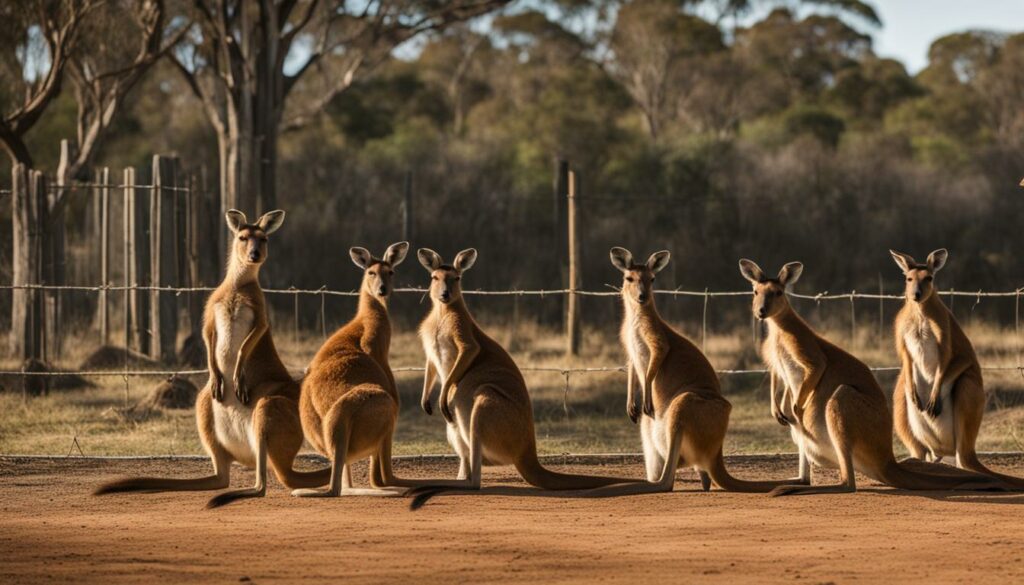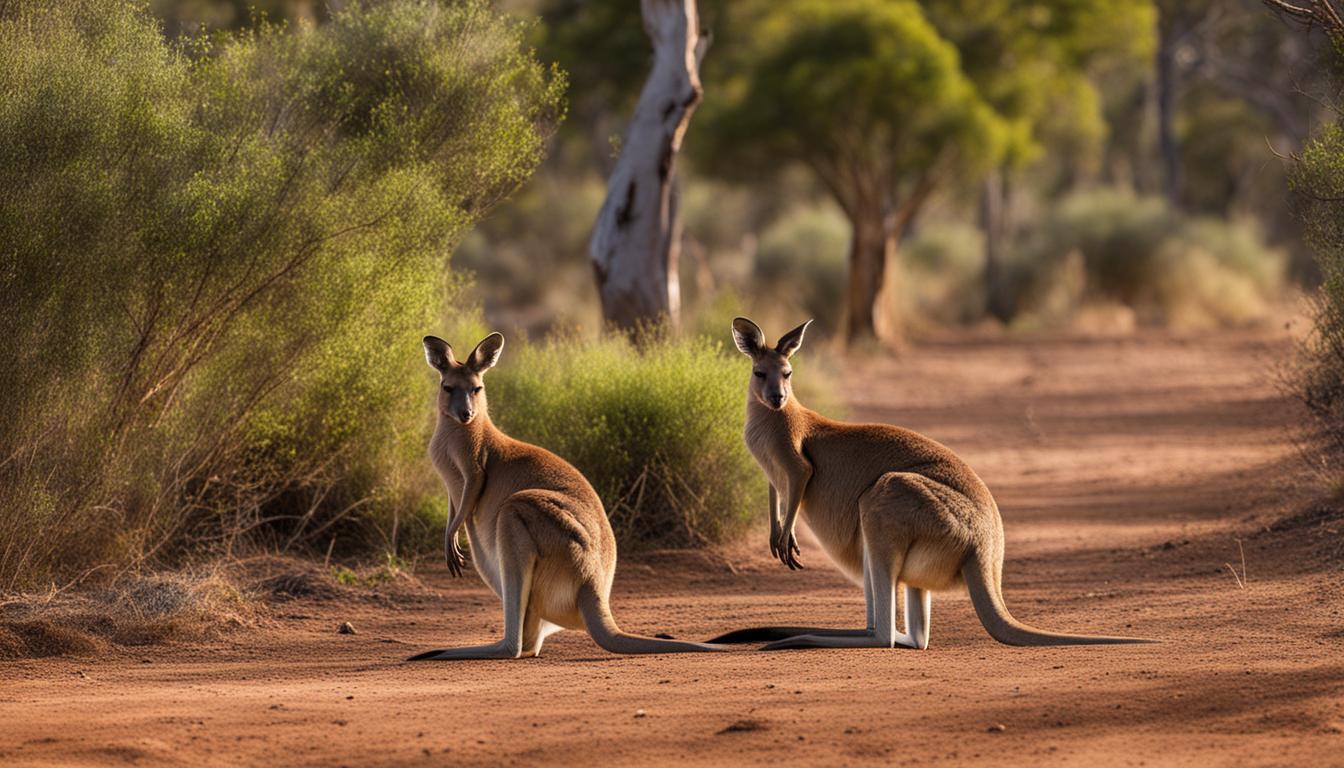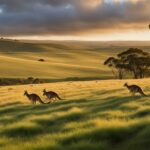Human-kangaroo conflicts can have a profound impact on kangaroo populations, raising concerns about their long-term survival. From hunting and habitat destruction to increased encounters and conflicts, the effects are significant.
Studies have shown that human activities such as hunting for meat and hide have resulted in a decrease in kangaroo populations. Additionally, as humans expand into kangaroo territory, the loss of habitat leads to more encounters between humans and kangaroos, further endangering these magnificent creatures.
These conflicts can have devastating consequences, with kangaroos being hit by cars or attacked by dogs, posing a serious threat to their populations. It is crucial to manage and reduce kangaroo-human conflicts to safeguard the future of kangaroo populations.
Understanding kangaroo behavior and habitat
Kangaroos, native to Australia, have fascinating behavior and inhabit diverse habitats. Their unique physical features, such as large hind legs and tails, allow them to engage in unique behaviors and adapt to various environments. Understanding their behavior and habitat is essential to managing kangaroo-human conflicts and ensuring the long-term survival of kangaroo populations.
Kangaroo Behavior
Kangaroos are herbivores, feeding on a wide range of plants. Their specialized teeth enable them to cut and grind vegetation, supporting their primarily plant-based diet. Interestingly, kangaroos can survive for extended periods without drinking water, as they obtain moisture from the plants they consume. This unique adaptation allows them to thrive in habitats where water sources may be limited.
“Kangaroos have specialized teeth for cutting and grinding vegetation.”
Kangaroos are social animals and live in groups called mobs. Within these mobs, individuals engage in various behaviors for communication and dominance. For example, males display dominance by boxing with their forearms and kicking with their powerful hind legs. These behaviors help establish social hierarchies and ensure cooperation within the group.
Kangaroo Habitat
Kangaroos are highly adaptable and can be found in diverse habitats across Australia, including grasslands, forests, and savannas. They have the ability to migrate in search of suitable food sources and water, allowing them to survive in ever-changing environments. However, as human activity expands into kangaroo territory, their habitats are increasingly at risk.
| Habitat Type | Characteristic |
|---|---|
| Grasslands | Wide open spaces with ample grazing opportunities for kangaroos. |
| Forests | Dense vegetation provides both food and shelter for kangaroos. |
| Savannas | A mix of grassland and scattered trees, offering a combination of food and cover for kangaroos. |
Protecting and preserving kangaroo habitat is crucial for their survival. It is imperative to strike a balance between human development and conservation efforts to ensure that kangaroos have access to suitable habitats for feeding, breeding, and raising their young. By understanding their behavior and habitat requirements, we can make informed decisions and take necessary actions to safeguard the long-term survival of kangaroo populations.
Threats to Kangaroo Populations
Kangaroos face numerous threats to their populations, with the primary threat being human impact. As human activity increases, kangaroos are hunted for their meat and hide, leading to a decline in their numbers. Additionally, the expansion of human settlements into kangaroo habitat results in increased encounters between humans and kangaroos, leading to conflicts and higher mortality rates for kangaroos. Predation by wild dogs is another significant threat, as they target kangaroo populations.
Climate change also poses a danger to kangaroos. Heatwaves and droughts, exacerbated by global warming, can negatively impact the availability of food and water sources, making it challenging for kangaroos to survive. These threats have contributed to a decrease in kangaroo populations in certain areas.
To fully understand the threats to kangaroo populations, it is crucial to analyze the impact of human activities, the role of climate change, and the predator-prey dynamics.
Impact of Human Activities
Human activities such as hunting and habitat destruction have a significant impact on kangaroo populations. Hunting for meat and hide has led to overexploitation, with kangaroos being targeted for their valuable resources. The loss of habitat due to human expansion further exacerbates the problem, leading to increased encounters between humans and kangaroos. These encounters often result in conflicts, road accidents, and attacks by domestic dogs, which pose a direct threat to kangaroo populations.
“[Kangaroos] face significant human threats due to hunting, habitat loss, and conflicts, which can have devastating effects on their populations,” says Dr. Jane Anderson, a wildlife conservation expert.
| Threats | Impact |
|---|---|
| Hunting and habitat destruction | Overexploitation and loss of habitat |
| Encounters with humans | Conflicts, road accidents, and attacks by domestic dogs |
| Climate change | Heatwaves and droughts affecting food and water sources |
| Predation by wild dogs | Direct threat to kangaroo populations |
Understanding the various threats to kangaroo populations is crucial for implementing effective conservation measures and ensuring their long-term survival in the face of human activities and habitat loss.
Managing kangaroo-human conflicts
When it comes to the conservation of kangaroo populations, managing kangaroo-human conflicts is of utmost importance. By implementing effective strategies, we can reduce the negative impacts of these conflicts and ensure the long-term survival of kangaroos.
Preventing kangaroo access to urban areas
One key solution to managing kangaroo conflicts is preventing their access to urban areas. This can be achieved through the installation of fences and vegetation barriers that create physical boundaries between kangaroo habitats and human settlements. By creating these barriers, we can minimize the chances of kangaroos entering urban areas and reduce the potential for conflicts.
Public education and awareness programs
Public education and awareness programs play a vital role in managing kangaroo-human conflicts. By educating communities about kangaroo behavior and promoting understanding, we can foster a sense of coexistence. These programs can highlight the importance of giving kangaroos their space, not approaching them too closely, and avoiding actions that may provoke aggressive behavior. Through education, we can reduce negative interactions between humans and kangaroos.
Control of feral predators and responsible hunting practices
Feral predators pose a significant threat to kangaroo populations. Implementing control measures for these predators, such as wild dog management programs, can help mitigate conflicts. Additionally, responsible hunting practices can play a role in managing kangaroo populations. Licensed and regulated hunting programs can help control kangaroo numbers while ensuring the sustainability of the species. These programs should be monitored to prevent overhunting and maintain a balance in kangaroo populations.
| Kangaroo Conflict Management Strategies | Benefits |
|---|---|
| Preventing kangaroo access to urban areas | – Reduces conflicts between kangaroos and humans – Minimizes the risk of injury or property damage |
| Public education and awareness programs | – Promotes understanding and coexistence – Reduces negative interactions |
| Control of feral predators and responsible hunting practices | – Mitigates threats to kangaroo populations – Maintains population balance |
Managing kangaroo conflicts requires collaboration between conservation organizations, government agencies, and local communities. By working together and implementing these effective strategies, we can strive towards a future where kangaroos and humans can coexist harmoniously.

Conservation efforts for kangaroos
Conserving kangaroo populations is of utmost importance to ensure their long-term survival. Several organizations are dedicated to the conservation and protection of kangaroos and their habitats. These organizations work towards implementing strategies that promote sustainable population management and address threats to kangaroo populations. Collaboration between these organizations, government agencies, and local communities plays a vital role in the success of these conservation efforts.
One key aspect of kangaroo conservation is habitat preservation. Organizations focus on conserving and restoring kangaroo habitats, ensuring that these areas remain suitable for kangaroo populations to thrive. By protecting their natural habitats, kangaroos can continue to find enough food and shelter, ultimately supporting their overall population health.
“The conservation of kangaroos is crucial not only for their own sake but also for the ecological balance of their habitats. By protecting kangaroo populations, we are ensuring the preservation of a unique and iconic species and contributing to the overall health of our ecosystems.” – Dr. Jane Peterson, Kangaroo Conservation Society
The role of population management
Effective population management is another important aspect of kangaroo conservation. Through responsible hunting practices and monitoring population numbers, organizations aim to ensure sustainable harvesting of kangaroos. By establishing proper quotas and implementing regulations, population management can help maintain healthy kangaroo populations while also meeting the needs of local communities.
Conservation organizations also collaborate with researchers to gather data on kangaroo behavior, population dynamics, and the impacts of various threats. This scientific research provides valuable insights into the conservation strategies needed to protect kangaroos effectively.
Overall, the dedicated efforts of conservation organizations, along with community engagement and government support, are essential in safeguarding kangaroo populations for future generations.
Conclusion
Managing kangaroo-human conflicts is crucial for the conservation of kangaroo populations. By understanding kangaroo behavior and habitat, we can effectively implement strategies to reduce conflicts and protect these iconic creatures.
Conservation efforts play a vital role in ensuring the long-term survival of kangaroos. Habitat conservation, responsible hunting practices, and predator control are all necessary components of kangaroo population conservation. Collaboration between stakeholders, including conservation organizations, government agencies, and local communities, is key in implementing and sustaining these efforts.
Through the management of kangaroo-human conflicts and the promotion of understanding, we can work towards a future where kangaroos coexist harmoniously with human activities. By prioritizing their conservation and taking steps to mitigate the impacts of human activities and habitat loss, we can ensure the continued existence of these unique and fascinating creatures for generations to come.
How do human-kangaroo conflicts affect the social dynamics and behavior of kangaroo groups?
Human-kangaroo conflicts can disrupt the established family roles in kangaroo groups. Increased stress from encounters with humans can lead to behavioral changes within the group, impacting mating, caregiving, and hierarchy. These conflicts may lead to a breakdown of the traditional family roles in kangaroo groups, affecting their social dynamics.
What are the similarities and differences in the impact of human-animal conflicts on kangaroo and leopard populations?
The impact of humanleopard conflicts on populations varies from kangaroos to leopards. While both face similar challenges, such as habitat loss and competition for resources, kangaroo populations are mainly affected by land development, whereas leopard populations suffer primarily due to poaching and illegal trade. Consequently, conservation efforts must address these distinct threats to ensure the survival of both species.
FAQ
How do human-kangaroo conflicts impact kangaroo populations?
Human-kangaroo conflicts, such as hunting and habitat destruction, have led to a decrease in kangaroo populations. These conflicts result in increased mortality rates for kangaroos, endangering their long-term survival.
What is the impact of human activities on kangaroos?
Hunting for meat and hide, as well as habitat destruction due to human expansion, are the primary threats to kangaroos. These activities lead to a decrease in kangaroo populations and increased encounters between humans and kangaroos.
What are the main threats to kangaroo populations?
The primary threats to kangaroo populations include hunting, habitat destruction, predation by wild dogs, and the impacts of climate change. These threats have resulted in a decrease in kangaroo populations in certain areas.
How can kangaroo-human conflicts be managed?
Kangaroo-human conflicts can be managed by implementing measures such as installing fences and vegetation barriers to prevent kangaroos from accessing urban areas. Public education and awareness programs can also help reduce negative interactions between humans and kangaroos.
What efforts are being made to conserve kangaroo populations?
Several conservation organizations are working to protect kangaroo populations. These efforts include habitat conservation, responsible hunting practices, predator control, and research on kangaroo behavior and population dynamics.
Why is collaboration important in kangaroo conservation?
Collaboration between conservation organizations, government agencies, and local communities is crucial for the success of kangaroo conservation efforts. By working together, stakeholders can implement effective strategies to protect and conserve kangaroo populations.











